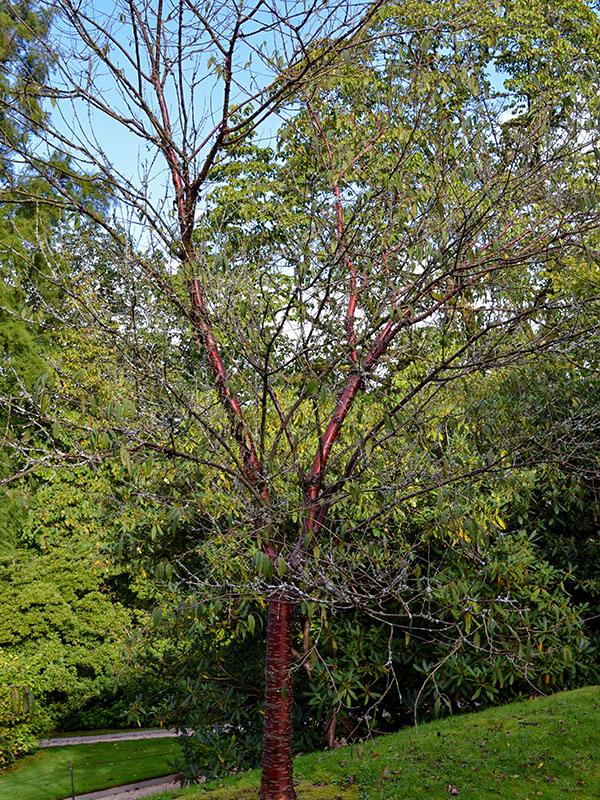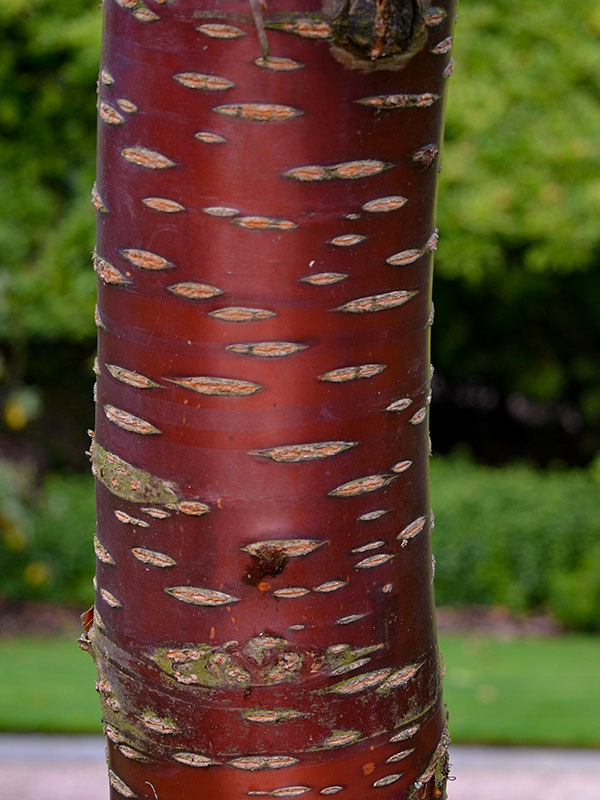| General Description | This is a deciduous, medium-sized tree which has dark green leaves with finely serrated margins, that turn an unimpressive yellow in the autumn. The bark is a somewhat rough, copper-red shiny, and exfoliating bark. It has clusters of 1 to 3 white flowers with plentiful stamens that surface simultaneously with the leaves in spring. |
| ID Characteristic | The unmistakable glistening red-brown, and exfoliating bark. The deep green lustrous leaves with identifiable, finely serrated margins. The distinct small white flowers cluster of 1-3 and little red drupe fruit. |
| Shape | It is a small tree which is round, oval to pyramidal in shape. Commonly trained into multi-stemmed specimens. |
| Landscape | This tree is best used in massing with understory plants that have colourful stems or bark, such as Cornus sanguinea ‘Midwinter Fire’. Its glowing, exfoliating red bark is well suited as winter interest in the back or borders of cottage and courtyard gardens, while keeping the trunk well exposed to display its main ornamental feature. Although tolerant of most soils, it is not suggested for park planting due to the plants toxicity to common pets like dogs and cats. This specimen also provides multi-season value because of its white clusters of flowers and cherry-like fruit. |
| Propagation | This tree can be successfully propagated as softwood cuttings in early spring if bottom heat is applied. If growing from seed, it requires 2-3 months of cold stratification and the process of germination can take up to 18 months. Plan to keep the plant in a greenhouse for its first winter, then proceed to plant them in late spring the following year. |
| Cultivation | This tree is rarely known to reach its full potential in North America due to cankers and borers. For optimal growth, it prefers full sun and requires moist but very well-drained soil because of its susceptibility to root rot. It can handle mildly acidic, neutral, and mildly alkaline soils that are moderately fertile. |
| Pests | When not growing in temperate biomes and well-drained areas, this tree is more susceptible to bacterial canker, root rot and borers. This tree also occasionally suffers from leaf miners, blossom wilt, aphids, and fireblight. |
| Notable Specimens | Lanhydrock Gardens, England, Cornwall. The Cambridge University Botanical Garden, located in Cambridge, United Kingdom. |
| Habitat | The Paperbark Cherry grows best in moist, well-drained soil in temperate biomes. It can typically grow naturally on mountains with steep elevations, forest ravines, and forest margins. |
| Bark/Stem Description | The bark is red-brown in colour with large definite horizontal lenticels which are typical in the Rosaceae family. With maturity, the bark bands and becomes dull, but peeling the translucent, exfoliating outermost layer will reveal young glossy bark. The slender branches bear the same deep red colour as the trunk. |
| Flower/Leaf Bud Description | The buds are a deep red colour, around 3 mm long and narrowly conical in shape. |
| Leaf Description | The 5-10 cm long and 1 cm wide lustrous, dark green, simple leaves appear in an alternate formation. The lanceolate leaves have finely serrated margins, hence the species name serrula meaning "A little saw". The venation can be described as a pinnate. In autumn the leaves turn an undistinguished yellow. |
| Flower Description | In the spring this monoecious plant bears bowl-shaped white flowers, 1 cm in diameter, with many prominent stamens. The solitary flowers with 5 petals tend to appear in clusters of 2-3. Although the flowers are pleasant, they, unfortunately, become hidden because they emerge at the same time as the foliage. |
| Fruit Description | The fruit produced by this tree can be classified as a drupe. It is small, around 1 cm long, and red in colour. It is not recommended to consume the seed specifically due to the presence of hydrogen cyanide in more members of this genus; this can be indicated by the bitter taste. |
| Colour Description | The leaves begin as dark green and shift to a dull yellow colour in autumn. The flower petals are pure white in colour. The fruit is a bright red colour which stands out in autumn. The bark is a bold reddish-brown colour which creates a beautiful contrast during cold grey months. |
| Texture Description | This plant would be described as having a medium texture. Although it has some glabrous bark, the constant exfoliation and large lenticels cause the tree to have a rougher texture. |

